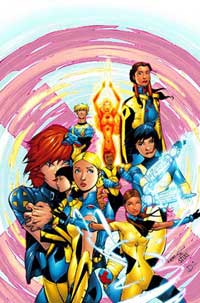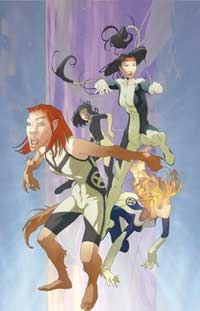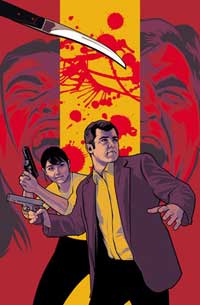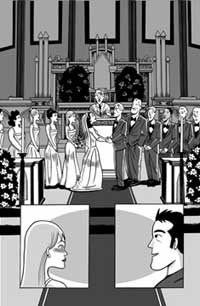- Comics
- Comics Reviews
- Manga
- Comics Reviews
- European Comics
- News
- Comics News
- Press Releases
- Columns
- Spotlight
- Digital Comics
- Webcomics
- Cult Favorite
- Back Issues
- Webcomics
- Movies
- Toys
- Store
- More
- About
By LJ Douresseau
December 14, 2003 - 10:23
Did working of the staff of a television production prepare you for working in a medium where the editors and bosses are so hands on or is my use of the phrase "hands on" really a sign of my gossip mongers mentality?
 CW: Actually in TV they were way more hands on. Or actually way more, "Thank you. We'll take that and rewrite it 'til it no longer resembles anything you turned in." Bill and Joe had lots of notes and ideas, but ultimately they left it to us to write and make it our own. So we were always able to take the Marvel guys in stride.
CW: Actually in TV they were way more hands on. Or actually way more, "Thank you. We'll take that and rewrite it 'til it no longer resembles anything you turned in." Bill and Joe had lots of notes and ideas, but ultimately they left it to us to write and make it our own. So we were always able to take the Marvel guys in stride.
Recently, a lot has been made in the fan press of Bill Jemas' notes to writers. You jokingly mentioned getting Jemas notes. Would you mind sharing an example of one if that's not a breach of something official?
CW: Bill was very concerned with making this book accessible to people who didn't have years of comics history to draw on. However, he took it a bit too far once. We originally had Dani doing voice over in Issue 1. And in it she had commented on the fact that the news had not been good recently, particularly not for mutants. Bill read that and asked why mutants would be in the news. He cited that he read the newspapers and watched TV and never saw stories about mutants. You know, there's really not a way to counter that note.
Were either of you very familiar with the original series, from the concept's creation by Chris Claremont and Bob McLeod to the Louise Simonson and Rob Liefeld work? Did Marvel editorial specifically ask you to avoid that past or only some of it?
ND: I read the original series, though I'm discovering my memory of it isn't nearly as good as that of our readers. But I only read it until it was completely remade via Cable and Rob Liefeld. That stuff wasn't really for me. But I had an understanding of the "classic" team in particular and a deep affection for them. On the other hand, Christina had read plenty of comics, but knew nothing about the New Mutants. We used to joke that we made the ideal team for a book like this. I would make sure it kept the right feel and didn't throw out what came before. And she would make sure it worked for people who knew nothing about the original book and was good storytelling in its own right. Marvel's preference was more in Christina's direction. Though C.B. was, like me, a fan of the old book. But if Marvel stepped in on those issues, it was always in favor of new reader accessibility.
You've mentioned before that you have no say in who draws the book, but does having faux anime/manga illustrators shape how you tell your stories?
CW: Not really. We write the way we write. We've tried to keep panel count down and we're not using our typical voiceovers or thought balloons (which we've never used, but can certainly stand in for voice over). As a result, we rely on the artist to really make our characters act.
Would you mind telling everyone about Three Strikes - the story and characters behind it?
 ND: THREE STRIKES is the story of two men, one running from the law, and the other the bail enforcement agent hired to bring him back. Rey Quintana is a guy just starting his life - he's in college, and working. But he has a past in a gang and makes a stupid mistake by shoplifting for his girlfriend's birthday. The District Attorney takes Rey's past problems, and turns the shoplifting charge into a third strike. So what was a minor crime becomes a 22 year sentence. Not seeing any options, Rey hits the road with one of his old gang buddies, Billy. Noah Conway is an ex-cop whose focus on his job cost him his marriage. He tried to save things by retiring early, but his marriage ended anyway, leaving him a bitter bail enforcement agent (bounty hunter) and with a teenage daughter who kind of despises him. On a week when Noah is supposed to have his daughter Shelley with him, he takes on a small job - tracking down Rey Quintana. The book follows the chase, as the unsympathetic Noah starts to see Rey's side, and the desperate Rey finds himself (due to Noah) unable to make an honest go on the road and becomes someone closer to the type of criminal the law saw in him.
ND: THREE STRIKES is the story of two men, one running from the law, and the other the bail enforcement agent hired to bring him back. Rey Quintana is a guy just starting his life - he's in college, and working. But he has a past in a gang and makes a stupid mistake by shoplifting for his girlfriend's birthday. The District Attorney takes Rey's past problems, and turns the shoplifting charge into a third strike. So what was a minor crime becomes a 22 year sentence. Not seeing any options, Rey hits the road with one of his old gang buddies, Billy. Noah Conway is an ex-cop whose focus on his job cost him his marriage. He tried to save things by retiring early, but his marriage ended anyway, leaving him a bitter bail enforcement agent (bounty hunter) and with a teenage daughter who kind of despises him. On a week when Noah is supposed to have his daughter Shelley with him, he takes on a small job - tracking down Rey Quintana. The book follows the chase, as the unsympathetic Noah starts to see Rey's side, and the desperate Rey finds himself (due to Noah) unable to make an honest go on the road and becomes someone closer to the type of criminal the law saw in him.
Would you mind describing the birth of Three Strikes? Was it meant to be a comic first? How did Brian Hurtt become involved again?
CW: Nunzio came out of the shower one morning ranting about how wrong the California Three Strikes law is. We talked about it and then how it could be translated into interesting story. At that point, we had done Skinwalker and really enjoyed the comics medium so we wanted to do it as a comic miniseries right off the bat. And we loved working with Brian so much that we immediately called him and asked him if he'd be interested in working on it with us.
From the opening page of 3S #1, you dropped the reader in hot water right along with Rey Quintana. It's almost like a suspense thriller, similar to Hitchcock's PSYCHO, and it seems as if you hardly give the reader a chance to catch her breath. Did you want to sort of put our backs against the wall, or am I misreading this?
ND: It's interesting (and cool) that you get that feeling from it. Sometimes, we're described as not being fast paced enough. And the "action," in terms of the chase, really doesn't start until Issue 2. But we did get things in motion for Rey very quickly, in terms of his plight. We wanted Rey's situation to hit him hard and fast, a small mistake that spirals to a 22 year sentence in no time. It's supposed to make it clear to him there is little option but go on the run, and make it clear to the reader that this kid is being mistreated. So the way it piles up quickly is by design.
I think I can describe 3S and Skinwalker as being kinetic like LONE WOLF AND CUB in that there is, for want of a better word, a sense of action. The characters are strong, and there are quite, character moments; however, I got the feeling that the story was saying, we gotta keep moving because I'm heading for a brick wall of an ending." How do you structure your stories to create that sense of dynamism, of movement, of never resting?
CW: We pride ourselves on doing character-based stories with scenes that service character first. To keep the plot moving the key is to make every one of those character scenes advance both the plot and the clock. There's a ticking clock in this story in the form of Noah. When will he catch up? So once he's on the case, each of his scenes with his daughter keeps the story moving by showing how he's trying to track down Rey. Even in the moment where Shelley runs away, we try to keep that clock ticking by having Noah get information that advances the case and forces him to have to make a choice about where his priorities lie.
If storytelling is communication, what are you trying to communicate to your readers or what would you like for them to get out of it? Is 3S well-crafted entertainment or are you aiming for something more?
 ND: We do have an agenda in telling this story. We want everyone who reads it to see the error in a system, like Three Strikes, that says "you have no more mistakes left. You're out of options to better yourselves." The minute we treat someone as if they are beyond hope, what choice do we leave them but to become the type of "career" criminal that the law is trying to punish? But if we just gave a lecture on the injustice of it all, it would hardly work as a story, and some of the people we want to make think will put it down. Besides, even I couldn't sustain 5 issues of a lecture. It HAS to be a good story first and foremost. We wanted character growth and a ticking clock, and a sense of drama. It's a tragedy - even if people see where it's going, they have to rail against cruel fate and want to keep reading at the same time. So we needed to create two compelling characters and treat this as a story, not a political statement.
ND: We do have an agenda in telling this story. We want everyone who reads it to see the error in a system, like Three Strikes, that says "you have no more mistakes left. You're out of options to better yourselves." The minute we treat someone as if they are beyond hope, what choice do we leave them but to become the type of "career" criminal that the law is trying to punish? But if we just gave a lecture on the injustice of it all, it would hardly work as a story, and some of the people we want to make think will put it down. Besides, even I couldn't sustain 5 issues of a lecture. It HAS to be a good story first and foremost. We wanted character growth and a ticking clock, and a sense of drama. It's a tragedy - even if people see where it's going, they have to rail against cruel fate and want to keep reading at the same time. So we needed to create two compelling characters and treat this as a story, not a political statement.
Are there heroes and villains in this, or is this more about choices characters make? After two issues, I see Rey as a hero, an outlaw by accident or necessity like Rob Roy or even John Rambo in First Blood. I see Noah as a bad guy because he's willfully blind to anything outside of his black and white world. So am I misreading this because of my substandard Louisiana education or am I close?
CW: You're not misreading it. But what we tried to do was make the line of hero and villain not so clear cut. It's not always black and white. Plus we see Noah and Rey as starting on opposite ends of a spectrum. And throughout the course of the story they travel along that spectrum. What may be very obvious at the beginning of the story, may not be so obvious by the end.
Are you making some kind of social commentary about prosecuting attorneys or D.A.'s when the D.A. sticks it to Rey on pages five, six, and 11 or is this merely a plot device? I really seems that not only is the D.A. not going to cut Rey some slack, but he's also going for the jugular.
ND: Definitely a statement. It's as if a lack of compassion is a thing to be proud of these days. That type - the DA who needs to beef up his tough on crime resume because he's running for office - what does he tell us about our culture? That compassion is weak and those who want to appeal to the masses cannot have any of it. I see too much of that in the real world. Most Americans seem more upset about a prisoner who was somehow coddled than about the thousands more who are in prison for too long on drug charges, or about the uneven application of the death penalty.
What's the reaction thus far to Three Strikes? Having you been trying to get New Mutants readers to try the series?
CW: The reaction that we've gotten has been very positive. Unfortunately Oni material usually flies under most people's radar. So not as many people as we'd have liked have seen it. But we're very proud of the fact that one person who read it and is a known conservative actually saw the point we were trying to make and liked the story very much. That's incredibly flattering and gratifying. We'd love for New Mutants readers to check out the miniseries and some of them have. But a lot of people who like the mainstream superhero stuff just aren't as interested in the smaller black & white stuff. But we take new readers wherever we can get them!
About Maria's Wedding, would you mind describing the story to the readers?
 ND: Maria's Wedding is the story of the Pirelli family, which is a typical large Italian family with a million and one stories, issues and fights. The story starts one year after the family has had a major blowup over the gay marriage of Joseph Pirelli. Joseph's brother Frankie vowed at the wedding to tell off the family members who had issues with two men getting married, and now the family is all under one roof for the wedding of Maria, a beloved cousin. Maria's marrying a man who may not be good enough for her, so people are sort of hoping Frankie will tackle that issue when he tackles the other one. Everyone expects him to say something, some hope for it, some dread it. Frankie isn't sure what to do, and is also looking to rekindle a high school romance with Maria's maid of honor. So it's sort of about these expectations Frankie has set for himself. It's also about family, and how you're stuck with them, and the only time you can choose family is at your wedding, so make the right choice.
ND: Maria's Wedding is the story of the Pirelli family, which is a typical large Italian family with a million and one stories, issues and fights. The story starts one year after the family has had a major blowup over the gay marriage of Joseph Pirelli. Joseph's brother Frankie vowed at the wedding to tell off the family members who had issues with two men getting married, and now the family is all under one roof for the wedding of Maria, a beloved cousin. Maria's marrying a man who may not be good enough for her, so people are sort of hoping Frankie will tackle that issue when he tackles the other one. Everyone expects him to say something, some hope for it, some dread it. Frankie isn't sure what to do, and is also looking to rekindle a high school romance with Maria's maid of honor. So it's sort of about these expectations Frankie has set for himself. It's also about family, and how you're stuck with them, and the only time you can choose family is at your wedding, so make the right choice.
What gave birth to the concept? CW: Nunzio's been grappling with this story for some time. It comes out of actual events in his family. When we started writing together, he decided he wanted to revisit the story. I think it probably helped to bring an "outsider" to the table. Sometimes you can be too close to something personally to make it into the story it needs to be. But at the same time I never wanted to overstep my bounds with something I considered "his story." But all in all, it was a fun project to work on.